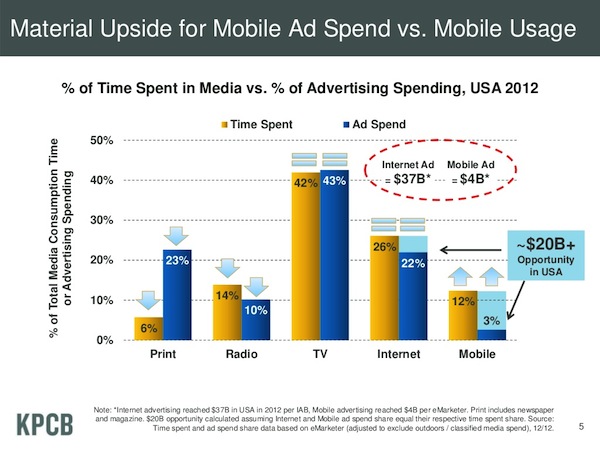It’s an annual moment of print realism here at Nieman Lab: The posting of the attention slide from Mary Meeker’s state-of-the-Internet slide deck. I guess I can cut and paste from last year’s post:
For those who don’t know it, Meeker — formerly of Morgan Stanley, at VC firm Kleiner Perkins since late 2010 — each year produces a curated set of data reflecting what she sees as the major trends in Internet usage and growth. It may be the only slide deck that qualifies as an event unto itself.
What’s useful about Meeker’s deck is that its core data serves as a punctuation mark on some big, ongoing trends. The kind of trends we all know are happening, but whose annual rate of progress can be hard to judge. Like, say, the continued demise of print.
The Meeker slide that always interests me most is the one where she shows how American attention is divided among various forms of media —and how that division lines up with where advertising dollars go. How much of our attention goes to television, say, versus how much of our advertising go there?
It’s not absolute dogma that the two — audience attention and advertising dollars — always be equal. But it makes sense that they would tend toward parity. More people listening to the radio should lead to more companies advertising on the radio, or vice versa.
Anyway, here’s the chart for 2011:

The two things that jump out at me: Print gets a lot more advertising than it gets attention. And mobile is the opposite. You’d think that would equalize with time.
And here’s 2012:

Equalization! Or at least the path to equalization, proportionately. Print loses attention, but loses ad dollars a bit more quickly; mobile gains attention, but gains ad dollars a bit more quickly. (Sizable margin of error here, it’s worth saying.)
And here’s 2013:

The print story remains the same: down in attention and in ad dollars. But note there is still a wide gap between the two — print still gets far more ad dollars than its hold on the American attention would seem to “deserve.” Print advertising is not coming back. It will fall further. Substantially further. All newspaper planning for the coming few years needs to reckon with that basic fact.
Mobile continues its rocket rise, and there’s still lots of room for ad revenue growth. And now it’s even eating away at the Great American Time Suck, television. Mobile is eating the world, and most news organizations make only a pittance off it.
Here’s the optimist’s spin for print: Not all forms of media are equally useful for advertising. Mobile, thus far, has been notoriously difficult to monetize through advertising; app purchases and in-app payments are the dominant ways for companies to make money on phones. Display advertising doesn’t work as well on such small screens, and search ad revenue is reduced.
If that’s true, maybe print is just mobile’s opposite: uniquely aligned with an advertising model, with big lush expanses of newsprint aching for a cell phone provider’s printed embrace.
Maybe so! I buy that, a little. But Meeker’s slide deck is that useful, punctuating reminder of the deeper trend lines of the publishing business. And for newspapers, they’re not good, and they’ve still got a ways to go down.
Go check out the full presentation — lots more interesting stuff in there.